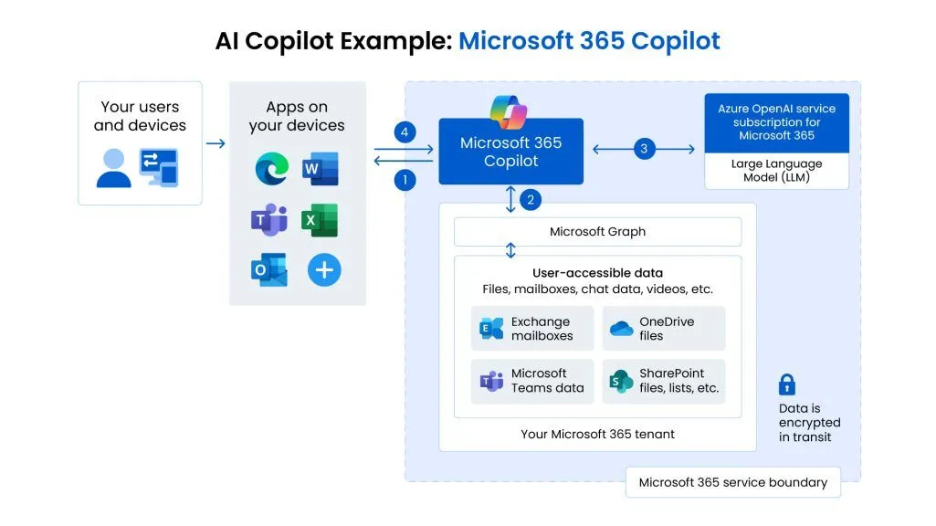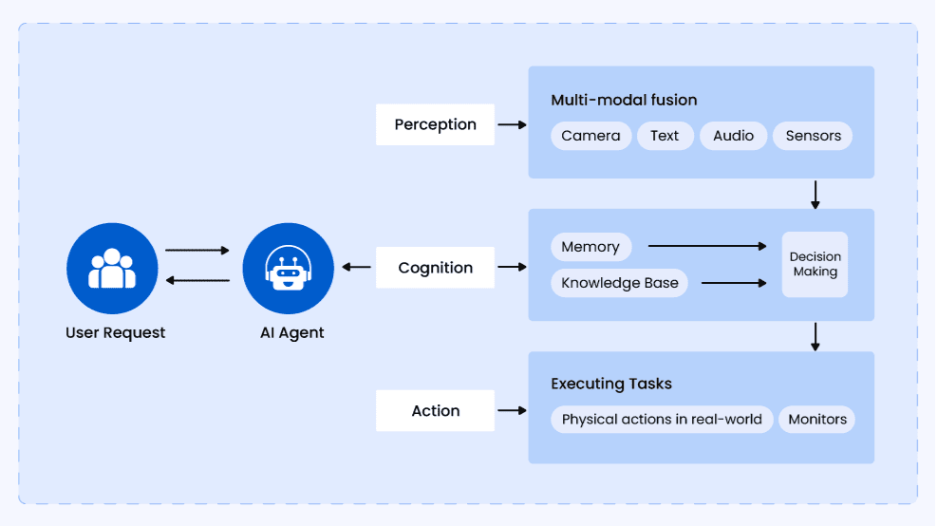
Domo の自動データフローエンジンを使用すれば、ゲームの視聴者数を予測する際にかかる手動プロセスを数百時間短縮できました。
The hype around generative AI isn’t slowing down. In fact, it continues to grow. Did you know that of the roughly 359 million companies worldwide, 280 million use AI in at least one of their business activities? With the growing adoption of generative AI, its market volume is expected to grow to nearly USD 442.07 billion, with a 36.99 percent CAGR from 2025 to 2031.
However, the growth of generative AI isn’t exactly linear. Different organizations are approaching the use of AI in their own unique ways based on their individual use cases. The result is that two main approaches have emerged: AI copilots and AI agents.
While both approaches can improve your workflows, the question is not about which one is best. Rather, it’s about figuring out which one works best to solve your specific challenges.
In this article, we’ll compare both AI solutions by looking at their features, uses, and considerations to help you choose the best option for your needs. We’ll also discuss how Domo can assist you in developing autonomous AI for your business.
Let’s explore how AI copilots and AI agents differ in their capabilities, autonomy, and ideal use cases.
Let’s break down both AI approaches in further detail, starting with why AI copilots are the go-to collaborative assistant.
The collaborative assistant: Understanding AI copilots
A copilot is a collaborative AI-powered assistant that works alongside you, offers insights, and helps you be more productive and creative. While they use AI models to process information and provide real-time support and contextual guidance, they do not operate independently.
Here are some key capabilities and features of AI copilots:
Real-life examples of AI copilots
AI copilots are changing the way we work by offering real-time help and suggestions. For example, GitHub Copilot helps you write code by understanding what you’re working on and offering personalized recommendations. In applications like Microsoft 365 Copilot, AI assistants generate content, rephrase text, analyze data, and even suggest formulas or create visuals based on your document.
AI copilot also engages in real time, responding to questions, providing feedback, and offering suggestions based on the current context. Some copilots, like Snowflake Copilot, use natural language processing (NLP) to translate user questions into queries, like SQL queries to retrieve and analyze data.

Microsoft 365 Copilot Example Workflow | Source
AI copilots excel in tasks requiring supervision, but their reliance on continuous input limits their autonomy. For a more independent solution, let’s turn to AI agents, the autonomous executors.
The autonomous executor: Understanding AI agents
When comparing AI copilots vs AI agents, agents are a more advanced form of artificial intelligence (AI) that operate independently. They complete entire tasks on their own, handling processes from start to finish like a human worker.
Unlike copilots, AI agents are not limited to providing suggestions or assistance. They reason and solve problems like you do and take actions all on their own to achieve specific business objectives. They are also capable of running business processes, adapting to new challenges, and improving over time.
Some key capabilities and features of AI agents include:

AI Agent Workflow Example | Source
Real-life examples of AI agents
The FordDirect Dealer AI Agent, developed in partnership with OneMagnify, uses the Domo Agent Catalyst to build AI solutions for its customers, including FordDirect. The FordDirect AI Agent provides dealers with easy access to information from 9 to 15 different dashboards, as well as new data that was previously inaccessible. Dealers can ask the AI agent questions using their voice on any device. They don’t need to log into different systems or search through reports.
This system provides valuable insights into customer behavior, including inventory interest, purchase or service likelihood, and the latest vehicle preferences. It’s useful for roles in sales, demand management, and inventory management, where data is often fragmented and siloed.
FordDirect is also planning to take its Dealer AI Agent a step further in automation, where it will detect different system events and trigger alerts to the dealership. For example, if the explorer window configurators are running low, it will alert dealers and ask if they want to order more. It can also make recommendations, such as automatically shifting media spend based on inventory levels.
While AI copilots and AI agents serve different roles, they exist along a continuum of AI enablement. Knowing when to use each is key to getting the most value for your business.
The copilot–agent continuum: When to use which?
Choosing between AI copilots vs AI agents comes down to what your business needs and how you prioritize AI automation to boost efficiency. They differ greatly in purpose, from how they interact to how much autonomy they bring.
Here’s a simple breakdown to help you decide the right option:
When to use an AI copilot
Choose AI assistants when you want real-time support while staying in control. They work best as digital companions rather than task owners. Use AI copilots when:
When to use an AI agent
Unlike copilots, AI agents are your operational executors. They are built to take full ownership of tasks from start to finish, without constant check-ins.
Deploy agents when:
Strategic implementation considerations
Rolling out AI copilots and agents requires a thoughtful approach to maximize benefits and reduce risks. Here’s how you can make the transition smoother and more impactful:
With a clear understanding of when to use copilots versus agents, let’s examine the value AI agents bring to business intelligence through automation.
The value of AI agents in business intelligence
Autonomous AI agents are delivering tangible, bottom-line results across industries such as finance, consulting, customer service, and logistics. For many enterprises, business AI automation initiatives driven by these agents have cut costs by 30–50 percent, while also delivering faster and more consistent operations.
For example, H&M’s virtual shopping assistant answered 70 percent of customer questions automatically, which increased sales by 25 percent and made resolving issues three times faster. Similarly, Microsoft, with extensive AI integration, saved over $500 million in its contact centers while increasing coding productivity (35 percent of code production and faster time to market).
Furthermore, about 19 percent of Fortune 500 companies, including Procter & Gamble and Unilever, now fully automate their financial reconciliation tasks using AI agents. These agents automatically check transactions, identify mismatches in ledgers, retrieve supporting document explanations, and complete audit logs.
Unlike older automation tools, these agentic systems handle unusual cases, adapt to different formats, and escalate issues intelligently, reducing the need for manual work.
However, success is not guaranteed as Gartner warns that nearly 40 percent of agentic AI projects may fail by 2027, often due to unclear goals, insufficient governance, or rushed implementation.
To avoid these pitfalls, businesses should have secure, scalable platforms with built-in guardrails. Domo’s Agent Catalyst offers an enterprise-grade framework to design, deploy, and manage AI agents reliably within complex operations.
Why choose Domo’s Agent Catalyst for building your first AI agent?
Domo Agent Catalyst supports the entire agent lifecycle with a secure, private foundation built on Domo’s AI platform. It’s engineered to analyze and complete business processes autonomously, while also maintaining security, governance, and human oversight.
This solution centers on a structured visual framework that simplifies agent creation into four steps.
What’s notable is that you can perform these four steps with a no-to-low-code approach. This empowers your organization to reduce agent setup time while reducing the need for complex development pipelines. This is what our customer, RXA@OneMagnify, referred to as “the perfect blend of innovation and control,” highlighting its governance, security, and AI automation capabilities.
Another advantage of using Domo is that through DomoGPT and role-based governance, every agent operates within an auditable platform. This means your agent actions are traceable, compliant, and aligned with data policies.
Explore how Domo helps you build and deploy AI agents at scale and go beyond copilots. If you want to learn more about AI, check out our Future of AI video series.
Author

Jace McLean is Domo’s senior director of strategic architecture. He has over 20 years of experience in data, analytics, and technology. His passion is solving complex problems in a data-driven manner. Prior to Domo, he spent two years at Cargill building out analytics capabilities for its North American finance department. He also led analytics teams at Target, focusing on new products in e-commerce.
